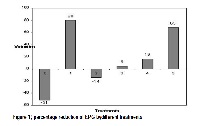Comparative effects of Piprazine of citrate® and papaya seeds on Ascaridia galli in layers Harco
Keywords:
citrate of pipérazine, papaya seeds, Ascaridia galli; layers HarcoAbstract
The present study has been realised in the farm ‘protein for all’ (PPT) located in Tori Sogbe in the Atlantique-Littoral province, from May to June 2011. A number of 300 layers Harco have been used for the test. They haven’t been detected before the experience which was to test the anti-parasitical efficiency of citrate of pipérazine® and of papaya seeds on Ascaridia galli. The weights of the eggs have been taken into a count before and after the treatment of the layers. The 300 hens have been separated into 6 groups of 50 hens which have been differently treated: The group 0, group of witness receives no treatment. Treatment 1 (2.5g/L of citrate of pipérazine® solution) for the group 1; treatment 2 (2.5g/L of papaya seeds solution) for the group 2 ; treatment 3 (2g/L of papaya seeds solution) for group 3 ; treatment 4 (3g/L of papaya seeds solution) for group 4 ; treatment 5 (4g/L of papaya seeds solution) for group 5. At state 1, it is to say before the treatment, the average quantity of the Eggs Per Gram (EPG) are statistically the same. In other words, the situation before the treatment is identical with the 6 groups. After the treatment, it is to say at state 2, we have noticed a difference highly significative between the treatments with an efficiency rate of -50% for the witness group ; 80% for the treatment 1 ; -14% for the treatment 2 ; 4% for the treatment 3 ; 16% for the treatment 4 and 65% for the treatment 5. In conclusion, we can retain that papaya seeds, no matter what is their dosage, have reduced significantly the number of EPG comparing to the witness group. But that reduction remains lower than the one of citrate of pipérazine® (2.5g/L of the solution). More over, the more the dosage of papaya seed increases, the more the reduction of Ascaridia galli parasitical eggs is important.
References
. Chrysostome C, Allard F. Enquête
sérologique et parasitaire sur la
pintade en élevage villageois au
Bénin. 2ème journée de recherche
avicole, Bénin, 1997.p. 4.
. Hounguèvou J. Essai d’utilisation des
graines de papaye dans le traitement
des Heterakidae (ascaridiose -
héterakidiose) du poulet local en
milieu réel. Cas de Ouidah Mémoire
de fin de cycle pour l’obtention du
Diplôme d’Etudes Agricoles
Tropicales (DEAT). Lycée Agricole
Mèdji de Sékou (LAMS), Bénin,
10-37.
. Adjanohoun EJ. La vie des enquêtes
ethnobotaniques pour les
pharmacopées africaines. Bull. Méd.
Trad. Pharm., 1995.3,75-83.
. Thiempont D, Rochette F, VAnparus
QFJ. Le diagnostic des verminoses
par examen coprologique. 2ème
édition, Janssen Research
Foundation. Beerse Belgique, 1995.
p. 29
. Villate D. Maladies des volailles. 1ère
Edition, Editions France Agricole,
France, 1997.p. 307.
. N’ Noume L. La filière poulet dans le
Sud - Bénin : Etat des lieux. Mémoire
de fin de cycle Collège Polytechnique
d’Abomey-Calavi/Université Nationale
du Bénin (CPU/UNB), Bénin, 2001.
- 67.
. Abou SBA. Passé, présent et
perspective de l’ethnomédecine
vétérinaire africaine. Revue Méd.
Pharm. Afr., 1994.2, 28-31.
. Dèka E. Effet anthelminthique de
quelques plantes sur les strongyloïdes
du porc au Bénin. 1ère journée de
recherche sur la porciculture, Bénin,
p. 8.
. Affognon KJ, Zinsou FC. Essai de
traitement des parasitoses gastrointestinales par la graine de papaye
chez les moutons Djallonké. Mémoire
de fin d’Etude pour l’obtention du
Diplôme d’Ingénieur des Travaux
(DIT). Université Nationale du Bénin
(UNB), 2000.24-41.
. Adoté H, Zinsou FE, Affognon KJ.
Efficacité antiparasitaire de la poudre
de graine de papaye (Carica papaya
sur les strongles gastro-intestinaux
des moutons Djallonké au Sud du
Bénin. Rev.Med.Vet. Pays trop., 2001.
, 225-229.


